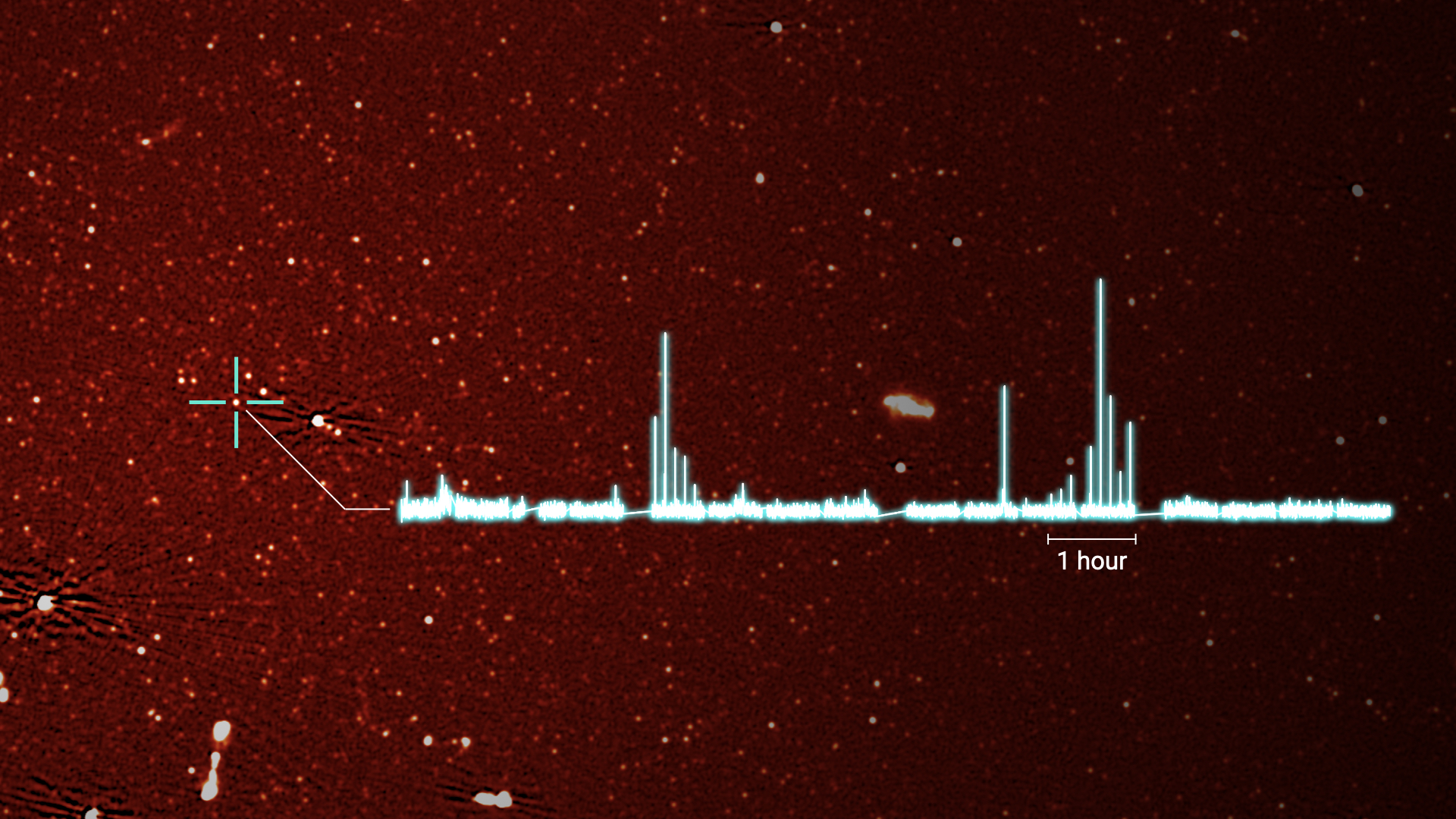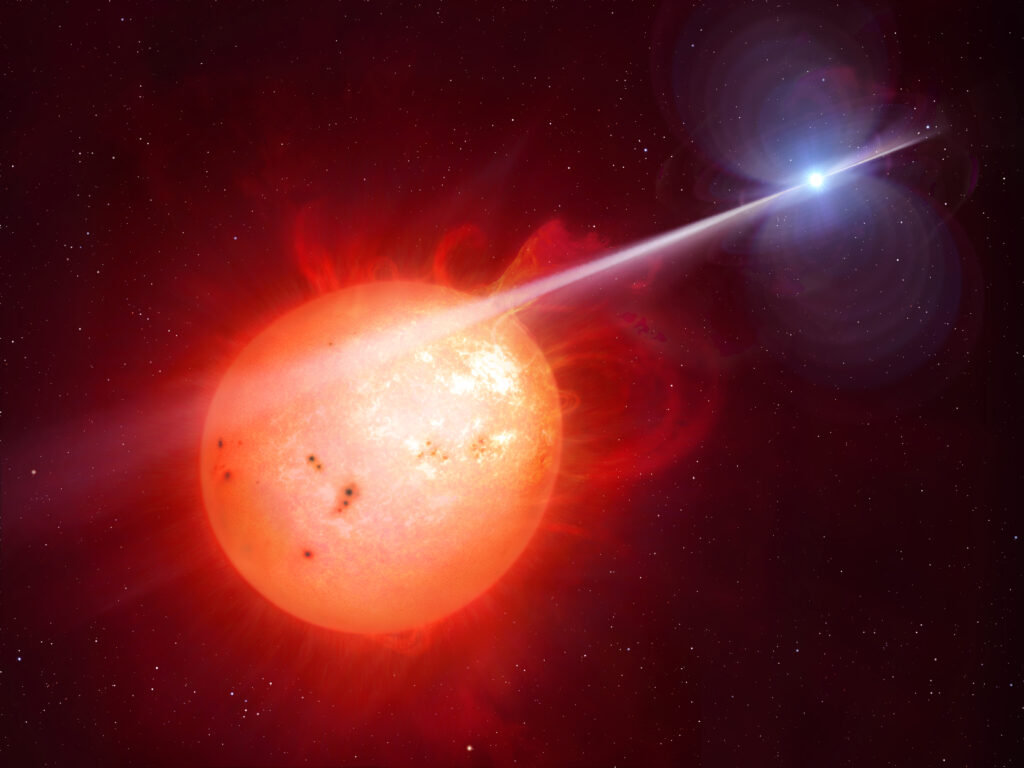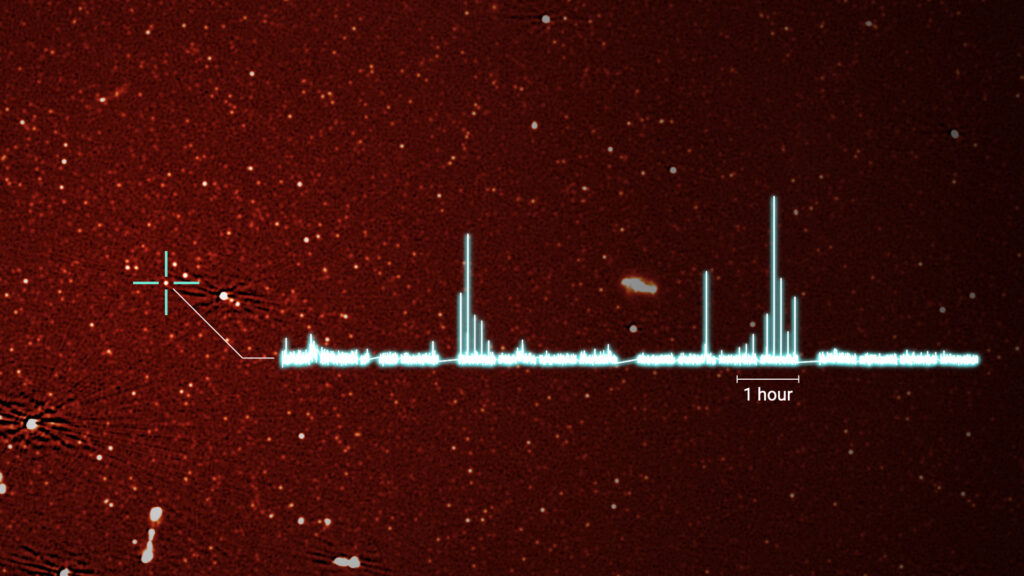
15 Jun South African Telescopes contribute to discovery of a new white dwarf pulsar
The discovery of a rare type of spinning white dwarf star in a binary star system – only the second one known – provides a new understanding of the role of magnetic fields in stellar evolution.
White dwarfs are small dense stars, typically the size of Earth but with a mass about 200,000 times greater, nearer to the mass of the Sun. This means that a teaspoon of white dwarf material would weigh around 15 tons. They form when a low-mass star, like the Sun, or even less massive, has burnt all its fuel, losing its outer layers. Sometimes referred to as “stellar fossils”, they offer insight into different aspects of star formation and evolution. White dwarfs begin their lives at extremely hot temperatures before cooling down over billions of years.
The rare type of white dwarf “pulsar” was discovered by an international team of astronomers, including from South Africa, namely the South African Astronomical Observatory (SAAO), the University of Cape Town (UCT) and the South African Radio Astronomy Observatory (SARAO), where a number of different telescopes were used to observe this new object. Some of the researchers were also involved in the discovery of the nature of the very first such system, found only in 2016, and known as AR Scorpii. These rapidly rotating and strongly magnetic (about a billion times the Earth’s magnetic field) white dwarf pulsars lash their stellar companion – a red dwarf – with powerful beams of charged particles and radiation, causing the entire system to brighten and fade dramatically over the minutes-long rotation period of the white dwarf. The bulk of the energy of these systems is powered by the slowing down of the spinning white dwarf, due to the drag exerted by its strong magnetic field.

An artist’s impression of a White Dwarf pulsar (credit: Mark Garlick)
A key theory which explains the strong magnetic fields is the “dynamo model” – that white dwarfs have dynamos (electromagnetic generators) in their cores, as does the Earth, but much more powerful. But for this theory to be tested, scientists needed to search for other white dwarf pulsars to see if their predictions held true.
Published today (15 June 2023) in Nature Astronomy, the research team describes the newly detected white dwarf pulsar, J191213.72-441045.1 (J1912-4410 for short), which is in a binary system with an orbital period of just over 4 hours. However, the white dwarf’s rotation period is just a little over 5 minutes long, meaning it’s spinning about 270 times faster than the Earth does.
Dr Ingrid Pelisoli, Research Fellow at the University of Warwick’s Department of Physics, and lead author, said: “The origin of magnetic fields is a big open question in many fields of astronomy, and this is particularly true for white dwarf stars. The magnetic fields in white dwarfs can be more than a million times stronger than the magnetic field of the Sun, and the dynamo model helps to explain why. The discovery of J1912−4410 provided a critical step forward in this field”.
“We used data from a few different survey telescopes to find potential white dwarf pulsar candidates, focusing on those that had similar characteristics to AR Sco. After observing a couple of dozen candidates, we found one that showed very similar light variations to AR Sco. We then followed these up with a number of other telescopes, both from the ground and space”.
Some of the telescopes used included the optical telescopes hosted at the Sutherland site of the SAAO, including the 10-m diameter Southern African Large Telescope (SALT).
Professor David Buckley of the SAAO, UCT and the University of the Free State, together with his SAAO and University of Johannesburg colleague, Professor Stephen Potter, initiated the South African optical observations. He states: “Like for the case of AR Sco, we were able to show that J1912-4410 also shows pulsed polarization and pulsed spectral lines, confirming its white dwarf pulsar nature”.
But equally important were observations done with the MeerKAT radio telescope array, undertaken following a request for Director’s discretionary time by Professor Patrick Woudt (UCT) and Professor Buckley. These observations revealed amazingly sharp radio pulses, at the same 5 min spin period, but only at very specific times, coinciding at precisely the same orbital phase. Professor Woudt stated: “These beautiful MeerKAT observations show how short repeat snapshot radio observations can reveal the strongly pulsed radio emission, as is demonstrated in these observations of J1912-4410”. Buckley added: “The radio light curve of J1912-4410 is remarkably different to AR Sco, with only a very brief period when the very narrow pulses are seen. In fact, in the first ~40 min observation we were lucky to catch them at all and if we’d not, then possibly the second longer 8-hour observation may not have happened.”
This new discovery is important as it supports the predictions made by the dynamo model. Due to their old age, the white dwarfs in the pulsar system should be cool. Their companions also have to be close enough that the gravitational pull of the white dwarf was, in the past, strong enough to steal mass from the companion, causing them to be fast spinning. All of those assumptions hold for the new pulsar found: the white dwarf is cooler than 13,000K, has a spin of around five minutes, and the gravitational pull and radiation from the white dwarf have a strong effect on the companion star.
“This research is an excellent demonstration that science works – we can make predictions and put them to the test, and that is how any science progresses”, Dr Pelisoli concludes.

A radio image from MeerKAT showing the position of J1912-4410, plus the radio light curve showing the occasional 5 min spin pulses (credit: Ian Heywood).
Link: https://www.nature.com/articles/s41550-023-01995-x
Contact:
Dr David Buckley: DAH.Buckley@saao.nrf.ac.za
